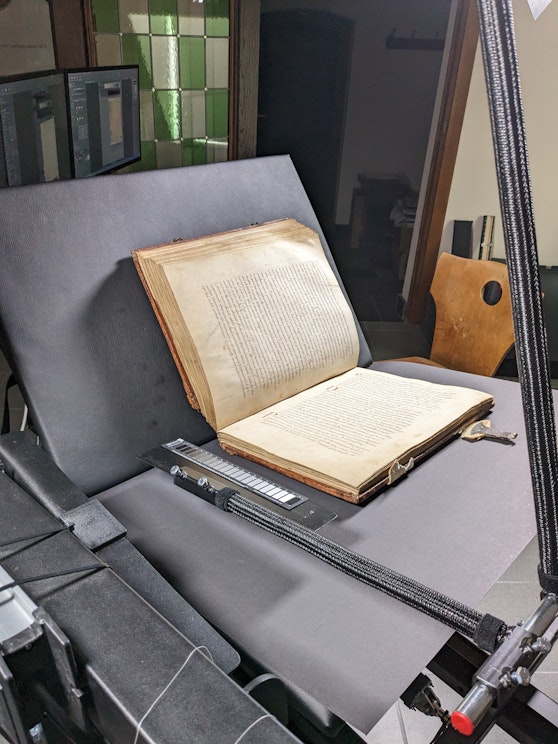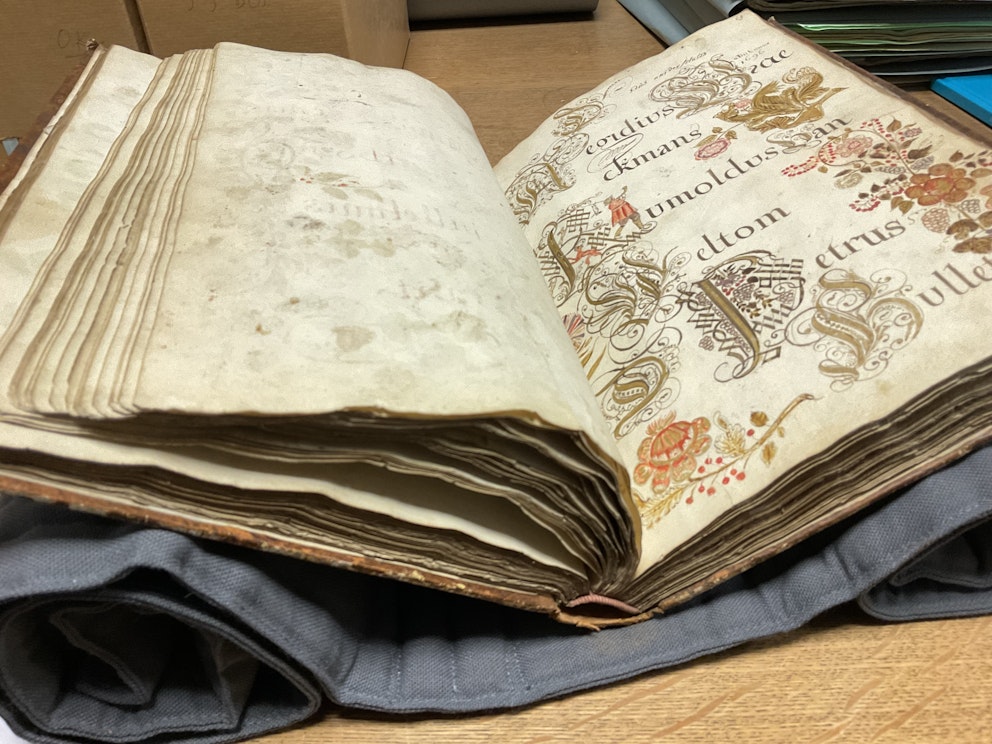
The GIVE-project is a digitisation effort of impressive proportions: over 800.000 newspaper pages, masterpieces and glass plate photographs were digitised and sustainably preserved. With the help of artificial intelligence, over 130 collections with audio and video received more accurate descriptions, making them more searchable. Impressive results, but the project also initiated intensive cooperation between heritage organisations, experts, technical professionals and more.
In this article, we put the spotlight on the people behind the project. This time, we asked our 10 questions to Lobke Vanden Eynden, Project leader digitisation and digital influx at meemoo.
Please can you tell us about your involvement in the GIVE project and your specific role?
I work at meemoo, so I’m right at the heart of the GIVE project. I’m the project leader for the digitisation initiative for masterpieces on paper or parchment – handwritten and early printed works. So I’m responsible for the overall management of the entire project. This includes the procurement process, liaising with collection managers and digitisation partners, and even assisting during the digitisation itself. I wasn’t alone in any of this, though; I worked alongside my wonderful colleagues at meemoo and our many cultural heritage partners.
Why do you think digitising the masterpieces is so important and valuable?
A masterpiece is, by definition, rare and indispensable. At the start of the GIVE project, there were 40 masterpieces on paper or parchment that did not yet have a high-quality digital replica. But digitisation is essential if we want to preserve our heritage with integrity. It ensures that the content of these masterpieces can withstand the test of time.
These items are fragile, and some cannot be easily viewed or studied because they are kept in places like abbeys or vaults. Digitising them makes them accessible to everyone, bringing the finest details of these handwritten and early printed works right into everyone’s living room.
As the icing on the cake, the GIVE project was honoured with a Digital Flanders Award, where the jury highlighted the societal value of the project, clearly demonstrating the relevance of our work.
What impact do you hope the GIVE project will have?
At meemoo, we dream of bringing the past to life and preparing it for the future. We aim to make valuable Flemish heritage digitally available to a wide audience and to inspire people to engage with heritage, whether in the classroom or in their leisure time or professional lives.
Within the cultural heritage sector, I hope that the GIVE project will demonstrate the importance of high-quality digitisation and sustainable archiving, as well as the added value of collaboration. We could never have accomplished this project without our more than 175 heritage partners!
Personally, I secretly hope that researchers will eagerly use the digital copies and make surprising discoveries in the manuscripts.
What challenges did you encounter in your work on the project, and how did you deal with them?
Each piece is unique, and the diversity of the 40 objects we digitised was truly challenging. Made of paper or parchment, bound or unbound, ranging from very small (10 cm) to very large (65 cm). Some have withstood the ravages of time well; others are in very poor condition, with tears and ink corrosion. And they are stored all over Flanders, from Bruges to Tongeren and everywhere in between.
Despite these differences, we wanted to approach the digitisation as systematically as possible. Preparation and dialogue were absolutely crucial.
Our digitisation partner GMS designed a custom-made mobile book cradle. But to design that cradle properly, we had to gather as much information as possible in advance about the 40 objects to be digitised. We also went to visit GMS in the Netherlands several times to monitor everything closely and discuss things thoroughly. This meticulous preparation helped us to achieve very impressive results together and elevate the project to a higher level.
What have you learned or discovered during this project?
I’ve discovered so many beautiful stories, people and masterpieces! As a historian, I’ve thoroughly enjoyed this journey through manuscripts – some dating back as far as the 10th century, others much more recent from the 20th century. I’ve learned a lot about how these historical books were made. The way a book is bound, for example, can affect how it lies when opened. That might not seem important, but we wanted to capture every detail of the pages, and the way a book lies has a significant impact when you’re trying to photograph it. Sometimes, a little extra foam or padding in a specific spot under the book worked wonders to bring much more of what’s written in the margins into view. Those were always little moments of triumph because we knew that those miniatures, musical notes or annotations were safely preserved for the future.
Which collaborations within the project have made the biggest impression on you, and why?
The collaborations with the 18 collection managers, from museums to archives and heritage libraries, were all very enjoyable and informative.
But working together with the ecclesiastical institutions, particularly the abbeys, was the most surprising to me. They are a group that we at meemoo don’t often work with, so it was quite exciting. You have no idea beforehand who or what you will encounter within the abbey walls. The reality is that I was received very warmly and absolutely inundated with fascinating stories about their collections, as well as some juicy tales. I invested extra effort in these new collaborations and am quite proud of the outcome. A strong bond has been formed, and there is mutual trust. Hopefully we will be welcome again to digitise more of their magnificent heritage!
What is your favourite masterpiece and why?
Just as it’s not done to choose a favourite child, I really shouldn’t have a favourite masterpiece. But secretly, the Antiphonary of Vorst (1500-1502) is just that. The books are in very good condition. The miniatures and illuminations still have such vibrant colours; they look as though they were painted yesterday. Each book weighs at least 30 kg. They barely fit on our mobile book cradle for digitisation. It was a serious challenge.
My heart also beats faster for the war diary of Virginie Loveling (1914-1918). The Boekentoren library at Ghent University preserves the diary, and it is a very special piece. It consists of almost 4000 A5 pages, sometimes sewn together with fragile thread, but also loose fragments, glued pieces, envelopes, newspaper articles, notes, corrections added later, and so on. A ‘scrapbook’ avant la lettre. And then there’s the compelling content of this ego-document from wartime. I found it an honour to spend 10 days handling the diary created by this remarkable woman.
The miniatures and illuminations still have such vibrant colours; they look as though they were painted yesterday.
Which masterpiece, manuscript, newspaper or glass plate do you think definitely still needs to be digitised, and why?
With the GIVE project, we digitised 40 objects made of paper or parchment, comprising 26 masterpieces. (A masterpiece can consist of multiple objects, e.g. an entire archive or a whole library can be recognised as a single masterpiece – ed.) There are still plenty of masterpieces made of paper or parchment that do not yet have a high-quality digital copy and really need digitising. There are many valuable handwritten or early printed works that are not recognised as masterpieces, but which I would also like to see immortalised digitally.
Who do you think benefits the most or is most impacted by the digitisation of heritage objects?
Above all, I hope to inspire future generations. Our high standards of quality and sustainable archiving are really aimed at enabling very long-term preservation. So I hope that the images will remain usable and accessible for a very long time – for schools, researchers or other interested parties.
Based on your personal experience and expertise, what recommendations would you make to someone who wants to work on a similar project in the future?
Preparation, preparation, preparation! In the GIVE project, good preparation was more than half the battle. I spent about two years preparing everything, to then digitise for ‘only’ 39 days.
A well-thought-out tender with sufficiently high quality standards is also crucial, but it’s equally important to try to reconcile practice and theory as much as possible, and to be pragmatic about it sometimes.
For anyone interested, there will be extensive final reports with all our advice and ‘lessons learned’. Highly recommended!

